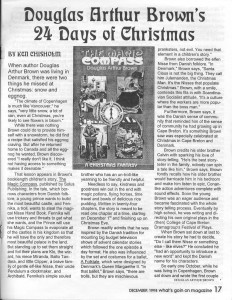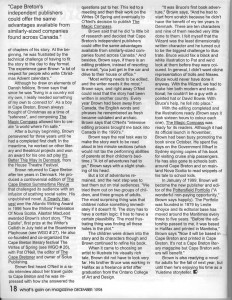
The Magic Compass
Solus Publishing (1998)
When author Douglas Arthur Brown was living in Denmark, there were two things he missed at Christmas: snow and eggnog.
“The climate of Copenhagen is much like Vancouver,” he says, “very little snow, a lot of rain, even at Christmas, you’re likely to see flowers in bloom.”
While there was nothing Brown could do to provide himself with a snowstorm, he did find a recipe that satisfied his eggnog craving. But after he returned home to Canada and all the eggnog he wanted, Brown discovered “I really don’t like it. I think not having access to something makes it desirable.”
That lesson appears in Brown’s booklength children’s story, The Magic Compass, published by Solus Publishing. In the tale, which borrows characters from Danish folklore, a young prince wants to build the most beautiful castle, and Fennika, a troll, wants to steal the magical Nisse Hand Book. Fennika will use trickery and threats to get what she wants, and the Prince will use his Magic Compass to evaporate all of the castles in his kingdom so that he will have the only and therefore most beautiful palace in the land.
But standing up to set them straight and foil their plans are Klo, the wizard, his niece Miranda, Balto Tandara, and little Clipper, a brave family of gentle elf-like Nisse, their uncle Pendulum a clockmaker, and Archibald, Fennika’s simple souled brother who has an un-troll-like yearning to be friendly and helpful.
Needless to say, kindness and goodness win out in the end with magic potions, flying horses, time travel and bowls of delicious rice pudding. Written in twenty-four chapters, the story is meant to be read one chapter at a time, starting on December 1st and finishing up on Christmas Eve.
Brown readily admits that he was inspired by the Danish tradition for mounting big budget television shows of advent calendar stories which followed the one episode a day format. He also was influenced by the set and costumes for a ballet, A Folktale, which were designed by Denmark’s Queen Margaethe II. “In that ballet,” Brown says, “there are trolls, but they are mischievous pranksters, not evil. You need that element in a children’s story.”
Brown also borrowed the elfen Nisse from Danish folklore. “In Denmark,” Brown says, “Santa Claus is not the big thing. They call him Julemanden, the Christmas Man. It’s the Nisses that populate Christmas.” Brown, with a smile, contends this fits in with Scandinavian Socialist attitude, “It’s a culture where the workers are more popular than the boss man.”
Furthermore, Brown says, it was the Danish sense of community that reminded him of the sense of community he had growing up in Cape Breton. It’s something Brown saw was especially celebrated at Christmas in Cape Breton and Denmark.
Brown credits his older brother Calvin with sparking his love of story-telling. “He’s the best storyteller in the family, nobody can spin a tale like him,” Brown says. Brown fondly recalls how his older brother would barricade him in his bedroom and make him listen to epic, Conan-like action adventures complete with sound effects. Soon the young Brown was an eager audience and became fascinated with the whole story telling process. Eventually by high school, he was writing and directing his own original plays in the (then) College of Cape Breton Dramagroup’s Festival of Plays.

So early one October, while he was living in Copenhagen, Brown sat down and wrote the first couple of chapters of his story. At the beginning, he was frustrated by the technical challenge of having to fit the story to the day to day format. The experience gave Brown “a lot of respect for people who write Christmas Advent calendars.”
Although he drew on elements of Danish folklore, Brown says that since he was “living in a country not my own, I really needed something of my own to connect to.” As a boy in Cape Breton, Brown always thought of Christmas as a time of “safeness”, and composing The Magic Compass allowed him to create “a world where I’m safe.”
After a bumpy beginning, Brown persevered for three years until he had a completed first draft. In the meantime, he worked on other literary and theatrical projects and won an award for his one act play It’s Better This Way In Denmark, from the House Theatre Festival.
Brown returned to Cape Breton after ten years in Denmark. He produced a controversial edition of The Cape Breton Summertime Revue that challenged its audience with an infusion of scathing social satire. His unpublished novel, A Deadly Harvest won the Atlantic Writing Award in 1996 from the Writers’ Federation Of Nova Scotia. Alastair MacLeod awarded Brown’s short story. “The Epistle”, first prize at the Writer’s Ceilidh in July held at the Boardmore Playhouse (see WGO # 27). He also co-founded and co-organized the Cape Breton literary festival The Writes of Spring (see WGO # 26), with Pat O’Neil, the editor of The Cape Bretoner and owner of Solus Publishing.
Brown first heard O’Neil in a radio interview about her travel guide to Cape Breton and he was impressed with how she answered the questions put to her. This led to a meeting and then their work on the Writes Of Spring and eventually to O’Neil’s decision to publish The Magic Compass.
Brown said that he did “a little bit of research and decided that Cape Breton’s independent publishers could offer the same advantages available from similarly-sized companies found across Canada.” And besides, Brown says, if there is an editing problem, instead of resorting to e-mail, “you just get in the car and drive to their house or office.”
“Most writing needs to be edited, and the writer needs it the most.” Brown says, and right away O’Neil could read that the story had been written in another country. Every year Brown had been away from Canada, the English words and phrases he remembered as fresh became outdated and archaic. Brown says that O’Neil’s “intensive editing process brought me back into Canada in the 1990s.”
Brown says the real task was to make the story work to be read aloud in ten minute sections (which would not tax the performing abilities of parents at their children’s bedtime.) “A lot of adventures had to go,” Brown says with a slight shaking of his head.
But a lot of adventures remained, and the next step was to test them out on trial audiences. “We tried them out on two groups of children, and three groups of adults. The most surprising thing was that children notice something immediately if it doesn’t fit. The story has to have a certain logic; it has to have a certain plausibility. The most frustrating thing was finding all these holes in the plot.”
The children were drawn into the story and its characters though and Brown continued to refine his book.
When it came to choosing an artist to illustrate his visually rich tale, Brown did not have to look very far. His brother Bruce was working in Halifax as a freelance artist after graduation from the Ontario College of Art and Design.
“It was Bruce’s first book adventure,” Brown says, “And he had to start from scratch because he didn’t have the benefit of my ten years in Denmark. There are ten characters and nine of them needed very little done to them. I felt myself that the Wizard was the least dimensionally written character and he turned out to be the biggest challenge to illustrate. Bruce would fax a black and white illustration to Pat and we’d look at them before they were coloured. In general, I didn’t want cliché representation of trolls and Nisses. Bruce would never have done it anyway. With the Wizard, we had to make him both modern and traditional; he couldn’t be a guy with a pointed hat or David Bowie. With Bruce’s help, he fell into place.”
With the editing completed and the illustrations ready (Brown says it took sixteen hours to colour each one), The Magic Compass was ready for its readers. Although it had its official launch in November, Brown had been busy promoting the book since October. He spent five days on the Government Wharf in Sydney signing copies of his book for visiting cruise ship passengers. He has also gone to schools both around Cape Breton and on mainland Nova Scotia to read snippets of his tale to school kids.
In January of 1999, Brown will become the new publisher and editor of the Pottersfield Portfolio (“A wonderful non-paying opportunity,” Brown says happily). The Portfolio was founded in 1979 by Leslie Choyce and its editorial base has moved around the Maritimes every three to five years. “Before the editorship passed to me, it was based in Halifax and printed in Manitoba,” Brown says “Now it will be based in Cape Breton and printed in Cape Breton. It’s not a Cape Breton literary magazine but Cape Breton writers will benefit.”
Brown is also readying a novel for adults for the fall of next year, but until then he’s enjoying his time as a Yuletime storyteller.

